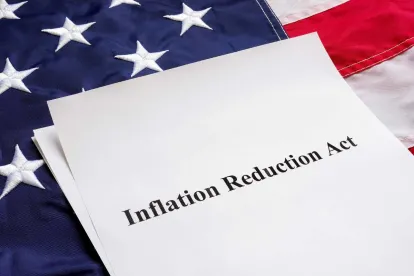Go-To Guide: |
|
The Inflation Reduction Act of 2022 (IRA) grants a number of tax credits and tax deductions for taxpayers for the purpose of inducing energy efficiency steps. One tax benefit the IRA grants is to make available an existing tax benefit not only to for-profit businesses, but for tax years commencing after Dec. 31, 2022, to tax-exempt organizations. Pursuant to amendments made to Section 179D of the Internal Revenue Code of 1986, as amended (the “Code”), tax-exempt organizations will be permitted to allocate tax deductions from energy-efficient property to the designers of the energy-efficient property, allowing a tax-exempt organization to monetize the tax benefit.
Code Section 179D
Code Section 179D was enacted in 2005 as part of the tax provisions of the Energy and Transportation Acts of 2005. Generally, Section 179D allows a deduction for the cost of energy-efficient commercial building property placed in service during the tax year. For these purposes, property is treated as placed in service in the year that the new property is placed in service and not in an earlier year in which any property that is part of the same project is placed in service. As originally enacted, the amount of the deduction was capped at $1.80 times the square footage of the building, over the aggregate amount of the deductions with respect to the building for all prior taxable years. The deduction was only available if the energy savings were equal to or in excess of 50% of the energy used in comparison to a reference building described in the Code.
As amended, for tax years commencing after Dec. 31, 2022, the deduction under Section 179D with respect to any building for any taxable year cannot exceed the excess (if any) of the “applicable dollar amount” times the square footage of the building, over the aggregate amount of the deductions under Section 179D with respect to the building for the three taxable years immediately preceding such taxable year (or, in the case of any such deduction allowable to a person other than the taxpayer, for any taxable year ending during the four-taxable-year period ending with such taxable year). The applicable dollar rate is based on the percentage of energy savings above 25%. The changes are effective for tax years commencing after Dec. 31, 2022.
Energy efficient commercial building property is property for which depreciation or amortization is allowable, which is installed on or in a building located in the United States and within the scope of Reference Standard 90.1, defined below, which is installed as part of the interior lighting systems, the heating, cooling, ventilation, and hot water systems, or the building envelope, and is certified as being installed as part of a plan designed to reduce the total annual energy and power costs for the interior lighting, heating, cooling, ventilation, and hot water systems of the building by 25% or more in comparison to a “reference building.”[1]
The “reference building” is a building that is located in the same climate zone as the taxpayer’s (i.e., the person or entity claiming the deduction) building and is otherwise comparable to the taxpayer’s building except that its interior lighting systems, heating, cooling, ventilation, and hot water systems, and building envelope meet the minimum requirements of Standard 90.1-2001.
With respect to any property, Reference Standard 90.1 means the more recent (A) Standard 90.1-2007 published by the American Society of Heating, Refrigerating, and Air Conditioning Engineers and the Illuminating Engineering Society of North America (ASHRAE/IESNA), or (B) the most recent Standard 90.1 published by the ASHRAE/IESNA for which the Department of Energy has issued a final determination and which has been affirmed by IRS, after consultation with the Secretary of Energy, for these purposes not later than the date that is four years before the date the property is placed in service.
Allocation of the Deduction to Designer
Prior to the IRA, Code Section 179D provided that a governmental entity could allocate the deduction under Section 179D to the designer of the energy-efficient commercial building property. The IRS issued Notice 2008-40, 2008-14 IRB 725, which contained rules for allocating the deduction to the designer of the energy-efficient property by a governmental entity.
The IRA amended Section 179D to permit a similar allocation to the designer of the energy-efficient property by organizations exempt from federal income tax that own the property. Many of the rules described in Notice 2008-40 may be applied to the cost deductions allocated by a tax-exempt organization.
Under Notice 2008-40, before a designer can claim a Code Sec. 179D deduction for property installed on or in a government-owned or publicly owned building, the designer has to receive a written allocation from the building owner. The allocation must contain the name, address, and telephone number of an authorized representative of the owner of the government-owned building; the name, address, and telephone number of an authorized representative of the designer receiving the allocation of the Code Sec. 179D deduction; the address of the government-owned building on or in which the property is installed; the cost of the property, the date the property is placed in service; the amount of the Code Sec. 179D deduction allocated to the designer; the signatures of the authorized representatives of both the owner of the government-owned building and the designer or the designer’s authorized representative; and a declaration, applicable to the allocation and any accompanying documents, signed by the authorized representative of the owner of the government-owned building, in the following form: “Under penalties of perjury, I declare that I have examined this allocation, including accompanying documents, and to the best of my knowledge and belief, the facts presented in support of this allocation are true, correct, and complete.”
In Notice 2008-40, the IRS explained that a designer may include, for example, an architect, engineer, contractor, environmental consultant, or energy service provider who creates the technical specifications for a new building or in addition to an existing building that incorporates an energy-efficient commercial building property or partially qualifying commercial property for which a deduction is allowed under Section 179D. A person who merely installs, repairs, or maintains the property is not a designer. In Notice 2008-40, a governmental entity could determine which designer is primarily responsible and allocate the full deduction to that designer or at the owner’s discretion allocate the deduction among several designers.
How Does an Exempt Organization Benefit from Code Section 179D?
Of course, a tax-exempt organization cannot directly benefit from the cost deduction since it does not generally pay income taxes. However, it can allocate the deduction to the designer of the energy efficient property. This tax benefit can be used in negotiating the price for design and engineering contracts. The promise to allocate the tax benefit can be used to reduce the cost of designing energy-efficient buildings or additions to buildings (but not the actual construction contracts). This tax benefit should reduce the cost of new building construction or improvements by tax-exempt organizations.
Under the prior law, the Tax Court ruled that only a taxpayer involved in designing the energy-efficient property can benefit from the Section 179D deduction. A taxpayer who only constructed the property is not eligible for the cost deduction allocation. This should be applicable to the amended Section 179D.
A tax-exempt organization should also consider sales tax benefits that can be obtained in entering into construction contracts. In general, many states treat a construction contractor as the ultimate consumer of materials and supplies purchased to fulfill a construction contract. This means that the contractor cannot purchase materials and supplies exempt from sales tax, even though the project is being constructed for a tax-exempt organization. However, some states allow a workaround to this problem so that the materials and supplies can be purchased tax-free. For example, in Florida, it is common for a Section 501(c)(3) tax-exempt organization to structure the construction contract as a purchase of building materials, avoiding sales taxes on the personal property. The tax-exempt organization then would enter into an agreement with the contractor for the labor to build the building and appoint the contractor as its agent to purchase the construction materials and supplies on behalf of the exempt organization, using purchase orders prepared by the contractor but signed by the exempt organization. Such a structure would allow the construction materials and supplies to be purchased tax-free.
The use of these benefits can be advantageous to tax-exempt organizations that own buildings.
FOOTNOTES
[1] Prior to the IRA, the required reduction was 50% or more.





 />i
/>i

